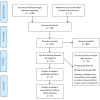Mental health interventions for suicide prevention among indigenous adolescents: a systematic review
- PMID: 35508004
- PMCID: PMC9671239
- DOI: 10.1590/1516-3180.2021.0292.R1.22102021
Mental health interventions for suicide prevention among indigenous adolescents: a systematic review
Abstract
Background: The legacies of colonization and of policies of forced assimilation continue to be a cause of intergenerational trauma, manifested through feelings of marginality, depression, anxiety and confusion, which place indigenous peoples at increased risk of suicide.
Objectives: To assess the quality, content, delivery and effectiveness of interventions for preventing suicides among indigenous adolescents.
Design and setting: Systematic review conducted with Cochrane methodology, Campo Grande, Mato Grosso do Sul, Brazil.
Methods: The Cochrane library, MEDLINE, EMBASE, CINAHL, LILACS and PsycINFO databases were searched for studies published up to February 2021. The following inclusion criteria were used: published in any language; interventions that aimed to prevent suicides among indigenous adolescents; randomized or non-randomized study with a control or comparative group; and validated measurements of mental health problems.
Results: Two studies were identified: one on adolescents in the remote Yup'ik community in south-western Alaska, and the other on Zuni adolescents in New Mexico. Both studies showed evidence of effectiveness in interventions for reducing some of the risk factors and increasing some of the protective factors associated with suicide. High levels of community engagement and culture-centeredness were key anchors of both studies, which ensured that the intervention content, delivery and outcome measurements aligned with the beliefs and practices of the communities. Both studies were judged to have a moderate risk of bias, with biases in sample selection, attrition and inadequate reporting of results.
Conclusions: The current evidence base is small but signaled the value of culturally appropriate interventions for prevention of suicide among indigenous adolescents.
Registration details: The study protocol is registered in the international prospective register of systematic reviews (PROSPERO); no. CRD42019141754.
Conflict of interest statement
Similar articles
-
Folic acid supplementation and malaria susceptibility and severity among people taking antifolate antimalarial drugs in endemic areas.Cochrane Database Syst Rev. 2022 Feb 1;2(2022):CD014217. doi: 10.1002/14651858.CD014217. Cochrane Database Syst Rev. 2022. PMID: 36321557 Free PMC article.
-
Mental health interventions for suicide prevention among indigenous adolescents: a systematic review protocol.BMJ Open. 2020 May 17;10(5):e034055. doi: 10.1136/bmjopen-2019-034055. BMJ Open. 2020. PMID: 32423928 Free PMC article.
-
Beyond the black stump: rapid reviews of health research issues affecting regional, rural and remote Australia.Med J Aust. 2020 Dec;213 Suppl 11:S3-S32.e1. doi: 10.5694/mja2.50881. Med J Aust. 2020. PMID: 33314144
-
Psychosocial interventions for preventing and treating depression in dialysis patients.Cochrane Database Syst Rev. 2019 Dec 2;12(12):CD004542. doi: 10.1002/14651858.CD004542.pub3. Cochrane Database Syst Rev. 2019. PMID: 31789430 Free PMC article.
-
Effectiveness of brief psychological interventions for suicidal presentations: a systematic review.BMC Psychiatry. 2018 May 3;18(1):120. doi: 10.1186/s12888-018-1663-5. BMC Psychiatry. 2018. PMID: 29724203 Free PMC article.
Cited by
-
Climate change and mental health of Indigenous peoples living in their territory: a concept mapping study.Front Psychiatry. 2023 Nov 6;14:1237740. doi: 10.3389/fpsyt.2023.1237740. eCollection 2023. Front Psychiatry. 2023. PMID: 38025449 Free PMC article.
-
The Effectiveness of Preventative Interventions to Reduce Mental Health Problems in at-risk Children and Young People: A Systematic Review of Reviews.J Prev (2022). 2024 Aug;45(4):651-684. doi: 10.1007/s10935-024-00785-z. Epub 2024 Jun 17. J Prev (2022). 2024. PMID: 38884876 Free PMC article.
-
Environmental degradation, climate change and health from the perspective of Brazilian Indigenous stakeholders: a qualitative study.BMJ Open. 2024 Sep 24;14(9):e083624. doi: 10.1136/bmjopen-2023-083624. BMJ Open. 2024. PMID: 39317490 Free PMC article.
-
Suicide prevention program on suicidal behaviors and mental wellbeing among school aged adolescents: a scoping review.Front Public Health. 2025 May 2;13:1506321. doi: 10.3389/fpubh.2025.1506321. eCollection 2025. Front Public Health. 2025. PMID: 40385626 Free PMC article.
References
-
- The Word Bank . Understanding Poverty. Indigenous People Available from: https://www.worldbank.org/en/topic/indigenouspeoples#1 .
-
- Lawson-Te Aho K, Liu JH. Indigenous suicide and colonization: The legacy of violence and the necessity of self-determination. International Journal of Conflict and Violence (IJCV) 2010;4(1):124–33. doi: 10.4119/ijcv-2819. - DOI
Publication types
MeSH terms
Grants and funding
LinkOut - more resources
Full Text Sources
Medical


